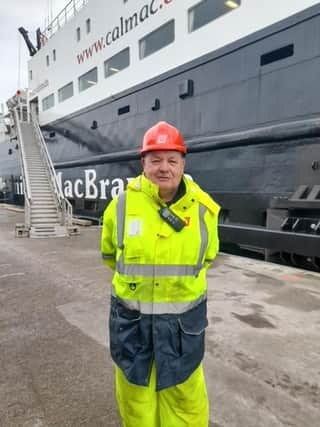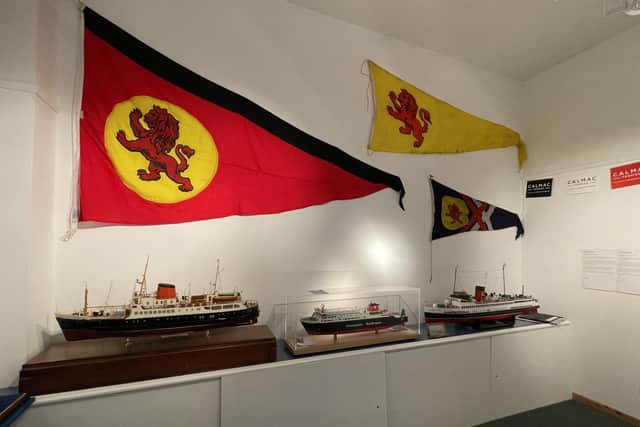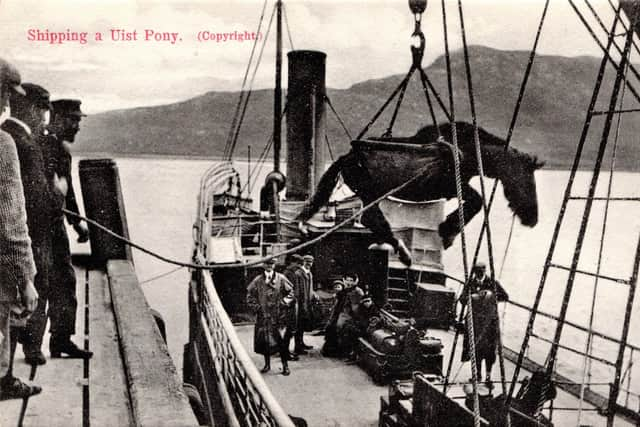Lifetime collecting MacBrayne memories


His house up the road from the pier where he works is crammed with model ships; the shelves groan under the weight of miniature trucks and buses; and his walls are decorated with pennants and posters from the days of David MacBrayne.
Now 50 years after he started, his collection is going on display at Taigh Chearsabhagh, Lochmaddy’s museum and Arts Centre. There’s a story of Cold War spying, a golfer who forgot there was a war on, and a silver cup awarded for a rescue at sea.
Advertisement
Hide AdAdvertisement
Hide AdThe exhibition is an emotional ambush for anyone who has ever sailed the Minch. The ferries mean so much to so many : the joy of coming home, the sadness of parting, relief after stormy crossings, mourning for loved ones brought back to be buried in island soil.


The museum provides space for the thoughts of former skippers and crew, passengers and business people, as well as the opinions of critics taking issue with the age and reliability of the fleet.
John Macdonald, though, has such affection for the ferries he could be a CalMac ambassador. Everyone who travels through Lochmaddy knows Big John whether they’ve seen him on the pier hauling out the gangway or in the car park in his hi-vis jacket taking in the tickets.
It is, he says, the only job he ever wanted : “I became interested in CalMac as a child. I used to go down to the pier to watch the boats and all the buses and David MacBrayne’s lorries and the crew were very good. We were allowed on the boats. The more we got on, the more involved we got, the more we liked being down there.
Advertisement
Hide AdAdvertisement
Hide Ad"I always wanted to work with CalMac ever since I was in school. But in those days you had to have someone there to help you in the door and I didn’t.


"My dad died when I was young and we were pushed in school towards computing so that’s the way I went. I came home after working in Glasgow. I worked with Royal Mail and then a fishing boat and a taxi service and then a job came up … I’ve been there 18 years now.“
The ferries have been such a vital part of island life for more than 150 years - all the way back to the steamer company David MacBrayne helped to found - it seems surprising there’s no permanent display anywhere in Scotland.
John Macdonald’s exhibition is unique: “I’ve been collecting CalMac stuff since I was eight years old. The first things were timetables and photographs.
Advertisement
Hide AdAdvertisement
Hide Ad"In the old days the boats supplied postcards. You had your own cabin so you could write cards or letters on David MacBrayne paper and you handed it to the chief steward and he would post it. I’ve got MacBrayne cards, dishes, silverware and 300 posters and timetables going back to 1850.
"I get a lot online but people may go through lofts when their parents have died and find things. Folk get to know I collect all this.”
One of the most striking exhibits is a set of three charts, part of a Cold War surveillance plan to keep an eye on Soviet shipping in the waters around the Hebrides. It was known as Operation Hornbeam.
John Macdonald explains: “Every piermaster and captain was given a set of charts showing Russian warships, submarines and merchant ships and they were given cards to phone if they saw anything. The charts weren’t allowed to be seen by anyone else. I’ve got some that weren’t destroyed. I had to get in touch with London and it took about two months for me to be given permission to put them on display.
Advertisement
Hide AdAdvertisement
Hide Ad"The amazing thing is CalMac was doing this and no one knew. People don’t know that CalMac played a part in keeping the country safe.”
The exhibition features islanders’ stories, often emotional accounts of homecomings and departures. Rhoda Morrison was brought up in Lochportain on North Uist: “I was maybe ten when I first went on the ferry and it was just fantastic, it was great.
"People just didn’t go on holiday like they do now so we went to see relatives in Scalpay and it was just phenomenal. I’ll never forget it. Getting all packed, getting your new clothes, going to the ferry - it was just a huge event, it was wonderful.”
Norman Macleod was brought up in Lochmaddy. As a boy, he would meet the boat when it came in : “The arrival of the ferry was always a night of excitement especially on a Friday when the comics arrived and were taken by lorry to Angus Beag’s shop. Everything was craned from the Lochmor in nets and on to the pier.
Advertisement
Hide AdAdvertisement
Hide Ad"At the Glasgow trade fortnight in mid-July the boat was always fully booked with locals who had moved to Glasgow to work returning home. Large numbers of their island families would be on the pier to greet them.”
Catriona Black was at Lochmaddy pier when the first dedicated car ferry arrived in 1964 : “It was the Hebrides that was on the route for many years. During our time at school, certainly when we were travelling back and fore to Inverness. I remember the Hebrides when it first came because all the children at Lochmaddy primary school were taken down to the pier and given juice and biscuits.
"I can’t say they were really fond memories because it involved leaving home. We used to pray for bad weather the night before because it meant the ferry wouldn’t necessarily sail the following day which meant we’d get an extra day at home.”
Many of the exhibits point up another role the ferries have played - the development of tourism in the islands. As far back as the 1860s, handbooks like Murray’s Scottish Tourist Advertiser were showcasing summer steamer tours to Portree and Stornoway. And David MacBrayne’s stylised posters presented the islands as a wild and romantic destination.
Advertisement
Hide AdAdvertisement
Hide AdThe silhouette of a clansman, wielding broadsword and shield, features on MacBrayne’s ferries and booklets since the 1930s. Indeed, John Macdonald himself has one decorating the bonnet of his car.
Nowadays, promotional material for the ferries is less misty-eyed, but CalMac still powers tourism for island communities.
Donald Maclean has worked on the Sound of Harris crossing since 1996. In his contribution to the exhibition he said the pressure on services up and down the islands had never been greater:
“Local people are going away more. Years ago people only went away if they had to go away.
Advertisement
Hide AdAdvertisement
Hide Ad“You’d be on the ferry for the whole day just to get to the mainland. As ferries improved people were travelling more.
"And the tourist season’s increased. In the early days we used to have a couple of weeks at Easter, and then eight weeks in the summer. Now we’ve got tourists for twelve months of the year. When it starts at Easter that’s it right through to October and you’ve got winter tourists as well.”
Angus MacInnes has just retired as a CalMac ferryman. He remembers the opening of the Berneray to Leverburgh route and says the fact cars were able make a direct crossing from North Uist to Harris several times a day made a huge difference to visitor numbers :
“It just exploded and opened up the islands. A lot of people come in through Oban or Stornoway and they travel the length of the islands and see the beauty we have out here. They thoroughly enjoy it.”
Advertisement
Hide AdAdvertisement
Hide AdAs the boats evolved, the services they were able to offer changed. The exhibition maps out the history of the vessels themselves from steamers to the introduction of the car ferries in 1964. MV Hebrides arrived in the Western Isles in April of that year.
John’s model fleet is so extensive, only a selection is on display:
“I’ve got 83 boats, 63 built by a man in Belgium. He used to come to the west coast every year. He got interested in David MacBrayne and CalMac and he started to make the boats and I’ve matched them up to photos of the originals and everything is bang on. He’s got the right number of windows, the right masts, the whole lot.”
And of course, today’s fleet is at heart of CalMac’s current problems. The delays in building two new boats at Ferguson’s in Port Glasgow are well documented.
Advertisement
Hide AdAdvertisement
Hide AdKenneth MacLeod is a former director of CMAL, the agency that procures vessels for the Scottish government. He was also chairman of the shipping company, Stena UK. He told the museum Ferguson’s yard should never have been contracted to build the new boats:
“This all hinges on the builder’s guarantee. I’ve had more than a hundred ships built under our supervision. The builder’s guarantee is the most important thing. It’s like an insurance policy. A letter was written from the chairman of CMAL to the Scottish government, to the Transport Minister, saying we cannot build this ship because you can’t get a builder’s guarantee and this is why you dare not proceed.“
The years of delay in building the Ferguson’s ships has kept in service ageing vessels elsewhere in the fleet, leading to breakdowns and disruption.
The impact has been particularly severe on South Uist and Barra, prompting a big local protest at Lochboisdale. John Daniel Peteranna has two businesses which he says depend on a reliable ferry service. He told the museum he and his business impact group want radical changes:
Advertisement
Hide AdAdvertisement
Hide Ad“I think the biggest thing we can hope for will be to relocate the HQ of the ferries and all the rest of it to an island.
I can’t afford to give up. Our investment in our holiday accommodation business - we need it to work, we need people here, we need the ferry to run as it should.
"That effectively is our pension. We’ve put our pension money into that building so it needs to have people in it. We don’t have an option, unlike the person in Gourock where if the train doesn’t go you’ve got the bus, if the bus doesn’t go you get a lift, if you can’t get a lift you can walk. It’s different for us. You can’t walk on the sea.“
The anger about disruption to services because of the age of the fleet is real but there is, paradoxically, a deep reservoir of affection both for the crews who sail the boats and the CalMac staff on the piers.
Advertisement
Hide AdAdvertisement
Hide AdKenneth MacLeod, the former CMAL director, summed it up like this: “The staff of CalMac are good people. There’s no question about that. CalMac is a well-run operation but they don’t have the hardware. They’re actually heroes, those guys in the office and on board the ships.”
That widely-felt affection is sustained by memories of what CalMac and MacBraynes have meant over the years.
John Macdonald’s exhibition aims to bring alive the stories of our islands and our ferries.
“Where The Sea Meets The Road - John Macdonald’s CalMac Collection” opens in Taigh Chearsabhagh, Lochmaddy on Friday 22nd March.